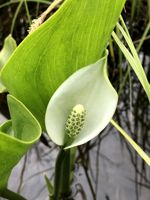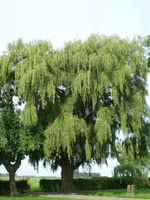Mon-Fri 9am - 5pm Mountain time
Golden Weeping Willow vs Water Arum
Calla palustris
Salix sepulcralis Chrysocoma
CUSTOM GROW
NOT AVAILABLE THIS SEASON - MIGHT RETURN
(we don't know if or when this product will be restocked)
Water Arum is a native perennial wetland plant known for its showy white oval sheaths (spathe) that surround a yellow-green, cylindrical flower spike (spadix). It has large, oblong, heart-shaped leaves on stems that rise above the water from shallow, spreading rhizomes. The blossoms are followed in late summer by tiny, pear-shaped fruits that ripen to bright red, adding ornamental interest to wet habitats.
Water Arum provides food for birds and small mammals that eat its berries, and its flowers attract pollinators. It can tolerate cold climates and forms colonies in shallow water and saturated soils. It is well-suited for ecological restoration, riparian planting, naturalisation, and habitat projects in wet and shaded environments.
The Golden Weeping Willow is a cultivar with bright yellow twigs and an attractive weeping shape. It is one of the most popular willows, with high ornamental value.
The Golden Weeping Willow has glossy green foliage during the spring and summer months, then the leaves turn a golden-yellow in the fall. The brown bark is furrowed and the overhanging branches keep their yellow tone, so they also have significant winter interest.
Water Arum Quick Facts
Golden Weeping Willow Quick Facts
Toxicity: toxic if ingested

